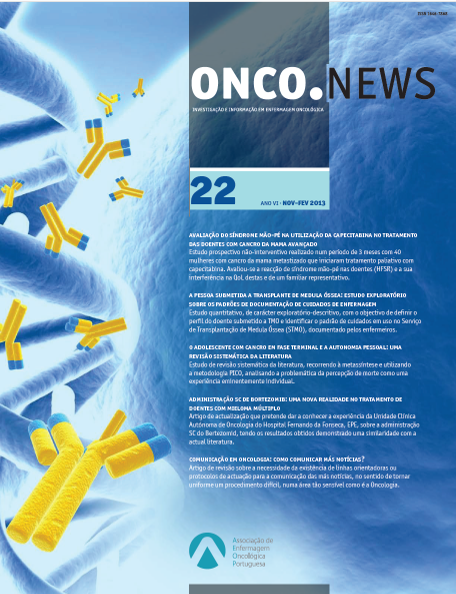Evaluation of hand-foot syndrome in the use of capecitabine in the treatment of patients with advanced breast cancer
DOI:
https://doi.org/10.31877/on.2013.22.01Keywords:
hand-foot skin reaction (HFSR), capecitabine, quality of life, dermatological toxicity, breast cancer, DLQI, FDLQIAbstract
Hand-Foot Skin Reaction (HFSR) is a potentially debilitating toxicity side effect mainly associated with 5-FU, liposomal doxorubicin and capecitabine that may have implications in treatment effectiveness and patient quality of life (QoL).
In order to prevent secondary effects, it is imperative to evaluate incidence and severity of HFSR in breast cancer patients receiving oral capecitabine chemotherapy, and to assess the impact on the QoL of patients who experience HFSR and their families. This is of major importance of our practice to improve our patients and these families. Education and formation with new strategies will minimize problems caused by this practice. Prospective, non-interventional study. This study was made to 40 female patients with advanced breast cancer whom started palliative chemotherapy with oral monotherapy capecitabine. The education period made to catch patient treatment was of 3 month.
All treatments taken were made without any other agents chemotherapy or any other target therapy. Over a 3-month period, 40 female patients starting capecitabine chemotherapy as a treatment for breast cancer (cycles with 14 consecutive days of capecitabine treatment each, with a one week interval between them) were evaluated. Patient and patients’ family HFSR-related QoL was assessed, respectively, using Dermatology Life Quality Index (DLQI) and Family Dermatology Life Quality Index
(FDLQI) questionnaires. The family was also assessed since same palliative were not fully independent regarding their daily basics activities.
In the evaluation of toxicity dermatology / skin scale was used CTCAE – Version 3.0. Regarding the incidence and severity of HFSR, the study suggested a statistically significant decrease in the percentage of patients with grade 1 toxicity and an increase of toxicity grades 2 and 3, for both hands and feet skin changes and rash/desquamation; around 4% of the nail changes had grade 4 toxicity
from the 6th week on. The analysis of the impact of HFSR in QoL showed a significant increase over time of the DLQI scores, while the FDLQI remained constant.
The results of this gave us the perspective that patients connect follow went during the treatment
decreases the coetaneous toxicity of the HFSR.
Downloads
References
Zuehlke R. Erythematous eruption of the palms and soles associated with mitotane therapy. Dermatologica 1974;148:90-92.
Burgdorf WH, Gilmore WA, Ganick RG. Peculiar acryl erythema secondary to high-dose chemotherapy for acute myelogenous leukemia. Ann Intern Med 1982; 97:61-62.
Feldman L, Ajani J. Fluorouracil-associated dermatitis of the hands and feet. JAMA 1985; 254:3479.
Blum J, Jones S, Buzdar A, et al. Multicenter phase II study of capecitabine in paclitaxel-refractory metastatic breast cancer. J Clin Oncol 1999; 17:485-493.
Clark AS, Vahdat LT. Chemotherapy-induced palmar-plantar erythrodysesthesia syndrome: etiology and emerging therapies. Support Cancer Ther. 2004 Jul 1;1(4):213-218.
Toxicity of fluorouracil in patients with advanced colorectal cancer: effect of administration schedule and prognostic factors. Meta-Analysis Group In Cancer. J Clin Oncol 1998; 16:3537-3541.
Comandone A, Bretti S, Grotta GL, et al. Palmar-plantar erythrodysestasia syndrome associated with 5-fluorouracil treatment. Anticancer Res 1993; 13:1781-1784.
Muggia FM, Hainsworth JD, Jeffers S, et al. Phase II study of liposomal doxorubicin in refractory ovarian cancer: antitumor activity and toxicity modification by liposomal encapsulation. J Clin Oncol 1997; 15:987-993.
Shields AF, Lange LM, Zalupski MM. Phase II study of liposomal doxorubicin in patients with advanced colorectal cancer. Am J Clin Oncol 2001; 24:96-98.
Abushullaih S, Saad E, Munsell M, et al. Incidence and severity of handfoot syndrome in colorectal cancer patients treated with capecitabine: a single-institution experience. Cancer Invest 2002; 20:3-10
Malet-Martino M, Jolimaitre P, Martino R. The prodrugs of 5-fluorouracil. Curr Med Chem Anticancer Agents 2002; 2:267-310.
Gressett SM, Stanford BL, Hardwicke F. Management of hand-foot syndrome induced by capecitabine. J Oncol Pharm Pract. 2006 Sep;12(3):131-141.
Chua D, Sham J, Au G. A phase II study of capecitabine in patients with recurrent and metastatic nasopharyngeal carcinoma pretreated with platinum-based chemotherapy. Oral Oncol 2003; 39:361-366.
Makhnova E, Bershanovich M. Experience with Xeloda (capecitabine) as a component of chemotherapy for relapsing cisplatin-resistant ovarian tumors. Vopr Onkol 2003; 49:193-197.
Van Cutsem E, Findlay M, Osterwalder B, et al. Capecitabine, an oral fluropyrimidine carbamate with substantial activity in advanced colorectal cancer: results of a randomized phase II study. J Clin Oncol 2000; 18:1337-1345.
Autier J, Escudier B, Wechsler J, Spatz A, Robert C, et al. Prospective Study of the Cutaneous Adverse Effects of Sorafenib, a Novel Multikinase Inhibitor. Arch Dermatol. 2008;144(7):886-892.
Kang YK, Lee SS, Yoon DH et al. Pyridoxine is not effective to prevent hand-foot syndrome associated with capecitabine therapy: results of a randomized, double-blind, placebo-controlled study. J Clin Oncol 2010;28(24):3824-3829.
Chalermchai T, Tantiphlachiva K,Suwanrusme, H, et al. Randomized trial of two different doses of pyridoxine in the prevention of capecitabine-associated palmar-plantar erythrodysesthesia. Asia Pac J Clin Oncol 2010; 6(3):155-160.
Downloads
Published
How to Cite
Issue
Section
License
Copyright (c) 2023 E Valério , A Rocha , I Silva , C Meneses

This work is licensed under a Creative Commons Attribution-NonCommercial-ShareAlike 4.0 International License.




